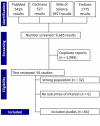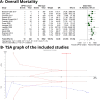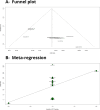Pharmacogenetics of DPYD and treatment-related mortality on fluoropyrimidine chemotherapy for cancer patients: a meta-analysis and trial sequential analysis
- PMID: 39350200
- PMCID: PMC11441158
- DOI: 10.1186/s12885-024-12981-5
Pharmacogenetics of DPYD and treatment-related mortality on fluoropyrimidine chemotherapy for cancer patients: a meta-analysis and trial sequential analysis
Abstract
Background: Fluoropyrimidines are chemotherapy drugs utilized to treat a variety of solid tumors. These drugs predominantly rely on the enzyme dihydropyrimidine dehydrogenase (DPD), which is encoded by the DPYD gene, for their metabolism. Genetic mutations affecting this gene can cause DPYD deficiency, disrupting pyrimidine metabolism and increasing the risk of toxicity in cancer patients treated with 5-fluorouracil. The severity and type of toxic reactions are influenced by genetic and demographic factors and, in certain instances, can result in patient mortality. Among the more than 50 identified variants of DPYD, only a subset has clinical significance, leading to the production of enzymes that are either non-functional or impaired. The study aims to examine treatment-related mortality in cancer patients undergoing fluoropyrimidine chemotherapy, comparing those with and without DPD deficiency.
Methods: The meta-analysis selected and evaluated 9685 studies from Pubmed, Cochrane, Embase and Web of Science databases. Only studies examining the main DPYD variants (DPYD*2A, DPYD p.D949V, DPYD*13 and DPYD HapB3) were included. Statistical Analysis was performed using R, version 4.2.3. Data were examined using the Mantel-Haenszel method and 95% CIs. Heterogeneity was assessed with I2 statistics.
Results: There were 36 prospective and retrospective studies included, accounting for 16,005 patients. Most studies assessed colorectal cancer, representing 86.49% of patients. Other gastrointestinal cancers were evaluated by 11 studies, breast cancer by nine studies and head and neck cancers by five studies. Four DPYD variants were identified as predictors of severe fluoropyrimidines toxicity in literature review: DPYD*2A (rs3918290), DPYD p.D949V (rs67376798), DPYD*13 (rs55886062) and DPYD Hap23 (rs56038477). All 36 studies assessed the DPYD*2A variant, while 20 assessed DPYD p.D949V, 7 assessed DPYD*13, and 9 assessed DPYDHap23. Among the 587 patients who tested positive for at least one DPYD variant, 13 died from fluoropyrimidine toxicity. Conversely, in the non-carrier group there were 14 treatment-related deaths. Carriers of DPYD variants was found to be significantly correlated with treatment-related mortality (OR = 34.86, 95% CI 13.96-87.05; p < 0.05).
Conclusions: This study improves our comprehension of how the DPYD gene impacts cancer patients receiving fluoropyrimidine chemotherapy. Identifying mutations associated with dihydropyrimidine dehydrogenase deficiency may help predict the likelihood of serious side effects and fatalities. This knowledge can be applied to adjust medication doses before starting treatment, thus reducing the occurrence of these critical outcomes.
Keywords: 5-Fluorouracil; Drug toxicity; Mortality; Pharmacogenomics.
© 2024. The Author(s).
Conflict of interest statement
The authors declare no competing interests.
The authors have no relevant financial or non-financial interests to disclose.
Figures
Similar articles
-
DPYD genotype-guided dose individualisation of fluoropyrimidine therapy in patients with cancer: a prospective safety analysis.Lancet Oncol. 2018 Nov;19(11):1459-1467. doi: 10.1016/S1470-2045(18)30686-7. Epub 2018 Oct 19. Lancet Oncol. 2018. PMID: 30348537
-
Clinical relevance of DPYD variants c.1679T>G, c.1236G>A/HapB3, and c.1601G>A as predictors of severe fluoropyrimidine-associated toxicity: a systematic review and meta-analysis of individual patient data.Lancet Oncol. 2015 Dec;16(16):1639-50. doi: 10.1016/S1470-2045(15)00286-7. Epub 2015 Oct 23. Lancet Oncol. 2015. PMID: 26603945
-
Patients homozygous for DPYD c.1129-5923C>G/haplotype B3 have partial DPD deficiency and require a dose reduction when treated with fluoropyrimidines.Cancer Chemother Pharmacol. 2016 Oct;78(4):875-80. doi: 10.1007/s00280-016-3137-0. Epub 2016 Aug 20. Cancer Chemother Pharmacol. 2016. PMID: 27544765
-
[Dihydropyrimidine déhydrogenase (DPD) deficiency screening and securing of fluoropyrimidine-based chemotherapies: Update and recommendations of the French GPCO-Unicancer and RNPGx networks].Bull Cancer. 2018 Apr;105(4):397-407. doi: 10.1016/j.bulcan.2018.02.001. Epub 2018 Feb 24. Bull Cancer. 2018. PMID: 29486921 Review. French.
-
Effectiveness and safety of reduced-dose fluoropyrimidine therapy in patients carrying the DPYD*2A variant: A matched pair analysis.Int J Cancer. 2019 May 1;144(9):2347-2354. doi: 10.1002/ijc.32022. Epub 2019 Jan 4. Int J Cancer. 2019. PMID: 30485432
Cited by
-
Changing landscape of advanced esophageal squamous cell carcinoma: Breakthroughs in systemic therapies (Review).Oncol Rep. 2025 Oct;54(4):120. doi: 10.3892/or.2025.8953. Epub 2025 Jul 19. Oncol Rep. 2025. PMID: 40682837 Free PMC article. Review.
-
Pharmacogenomics Tools for Precision Public Health and Lessons for Low- and Middle-Income Countries: A Scoping Review.Pharmgenomics Pers Med. 2025 Jan 30;18:19-34. doi: 10.2147/PGPM.S490135. eCollection 2025. Pharmgenomics Pers Med. 2025. PMID: 39902237 Free PMC article. Review.
-
PD-1/PD-L1 Inhibitors Increase Pathological Complete Response in Locally Advanced Gastric Cancer: A Meta-analysis and Trial Sequential Analysis.J Gastrointest Cancer. 2025 Jan 20;56(1):49. doi: 10.1007/s12029-024-01141-4. J Gastrointest Cancer. 2025. PMID: 39833372
-
Oncology Specialists' Perceptions and Insights Into Dihydropyrimidine Dehydrogenase Testing in Palestine.Cancer Rep (Hoboken). 2025 Jun;8(6):e70251. doi: 10.1002/cnr2.70251. Cancer Rep (Hoboken). 2025. PMID: 40556331 Free PMC article.
-
Fluoropyrimidine Therapy in Gastrointestinal Cancer: Balancing Survival Benefits and Cardiotoxicity Risks.JACC CardioOncol. 2025 Jun;7(4):357-359. doi: 10.1016/j.jaccao.2025.02.006. Epub 2025 Apr 8. JACC CardioOncol. 2025. PMID: 40202480 Free PMC article.
References
-
- Scartozzi M, Maccaroni E, Giampieri R, Pistelli M, Bittoni A, Del Prete M, et al. 5-fluorouracil pharmacogenomics: still rocking after all these years? Pharmacogenomics. 2011;12:251–65. - PubMed
-
- Longley DB, Harkin DP, Johnston PG. 5-fluorouracil: mechanisms of action and clinical strategies. Nat Rev Cancer. 2003;3:330–8. - PubMed
-
- Miura K, Shima H, Takebe N, Rhie J, Satoh K, Kakugawa Y, et al. Drug delivery of oral anti-cancer fluoropyrimidine agents. Expert Opin Drug Deliv. 2017;14:1355–66. - PubMed
-
- Dean L, Kane M. Fluorouracil therapy and DPYD genotype. In: Pratt VM, Scott SA, Pirmohamed M, Esquivel B, Kattman BL, Malheiro AJ, editors. Medical Genetics Summaries. Bethesda (MD): National Center for Biotechnology Information (US); 2012 [cited 2024 Jul 8]. http://www.ncbi.nlm.nih.gov/books/NBK395610/ - PubMed
Publication types
MeSH terms
Substances
LinkOut - more resources
Full Text Sources
Medical




